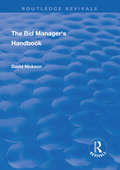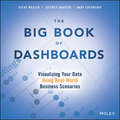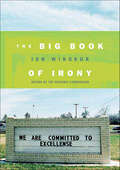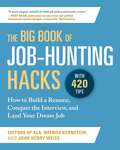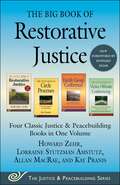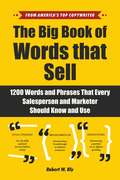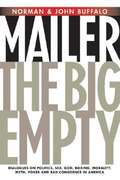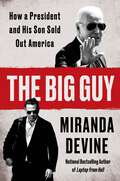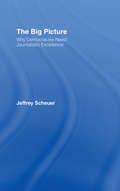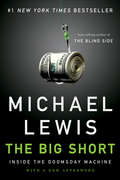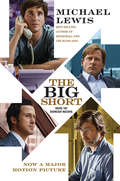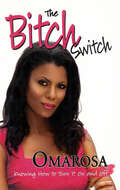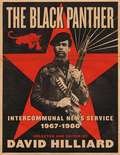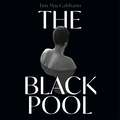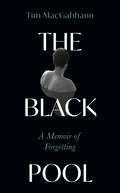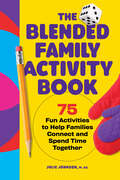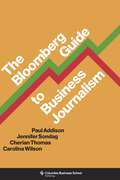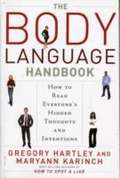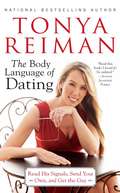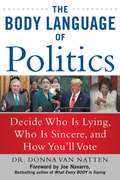- Table View
- List View
The Bible, Homer, and the Search for Meaning in Ancient Myths: Why We Would Be Better Off With Homer’s Gods (Routledge Monographs in Classical Studies)
by John HeathThe Bible, Homer, and the Search for Meaning in Ancient Myths explores and compares the most influential sets of divine myths in Western culture: the Homeric pantheon and Yahweh, the God of the Old Testament. Heath argues that not only does the God of the Old Testament bear a striking resemblance to the Olympians, but also that the Homeric system rejected by the Judeo-Christian tradition offers a better model for the human condition. The universe depicted by Homer and populated by his gods is one that creates a unique and powerful responsibility – almost directly counter to that evoked by the Bible—for humans to discover ethical norms, accept death as a necessary human limit, develop compassion to mitigate a tragic existence, appreciate frankly both the glory and dangers of sex, and embrace and respond courageously to an indifferent universe that was clearly not designed for human dominion. Heath builds on recent work in biblical and classical studies to examine the contemporary value of mythical deities. Judeo-Christian theologians over the millennia have tried to explain away Yahweh’s Olympian nature while dismissing the Homeric deities for the same reason Greek philosophers abandoned them: they don’t live up to preconceptions of what a deity should be. In particular, the Homeric gods are disappointingly plural, anthropomorphic, and amoral (at best). But Heath argues that Homer’s polytheistic apparatus challenges us to live meaningfully without any help from the divine. In other words, to live well in Homer’s tragic world – an insight gleaned by Achilles, the hero of the Iliad – one must live as if there were no gods at all. The Bible, Homer, and the Search for Meaning in Ancient Myths should change the conversation academics in classics, biblical studies, theology and philosophy have – especially between disciplines – about the gods of early Greek epic, while reframing on a more popular level the discussion of the role of ancient myth in shaping a thoughtful life.
The Bid Manager's Handbook
by David NicksonThis title was first published in 2003. Winning significant business on the right terms is an increasingly complex, challenging and time-consuming task, and a successful bid is a vital part of any business offering its services or products to another. This book aims to help you to enhance the probability of success in winning bids at the desired margins and to set-up and run effectively a bid management team. Aimed at two main groups of readers (sales staff managing multi-disciplinary bid teams and project and technical managers who find themselves managing a bid to support a sales campaign) it's a resource for the battle to win new business. Taking an extremely practical approach and using real life examples David Nickson leads the reader through every stage of planning for, producing and delivering a bid: knowing what needs to be done; knowing how to present the information to the prospective client effectively; gaining the writing and editorial skills needed to put a sales case across; identifying the skills that are needed to manage a bid. It also shows how to save time - the most important commodity in any bid as it is always a scarce resource - without affecting quality.
The Big Book of Dashboards: Visualizing Your Data Using Real-world Business Scenarios
by Andy Cotgreave Jeffrey Shaffer Steve WexlerThe definitive reference book with real-world solutions you won't find anywhere else The Big Book of Dashboards presents a comprehensive reference for those tasked with building or overseeing the development of business dashboards. Comprising dozens of examples that address different industries and departments (healthcare, transportation, finance, human resources, marketing, customer service, sports, etc.) and different platforms (print, desktop, tablet, smartphone, and conference room display) The Big Book of Dashboards is the only book that matches great dashboards with real-world business scenarios. By organizing the book based on these scenarios and offering practical and effective visualization examples, The Big Book of Dashboards will be the trusted resource that you open when you need to build an effective business dashboard. In addition to the scenarios there's an entire section of the book that is devoted to addressing many practical and psychological factors you will encounter in your work. It's great to have theory and evidenced-based research at your disposal, but what will you do when somebody asks you to make your dashboard 'cooler' by adding packed bubbles and donut charts? The expert authors have a combined 30-plus years of hands-on experience helping people in hundreds of organizations build effective visualizations. They have fought many 'best practices' battles and having endured bring an uncommon empathy to help you, the reader of this book, survive and thrive in the data visualization world. A well-designed dashboard can point out risks, opportunities, and more; but common challenges and misconceptions can make your dashboard useless at best, and misleading at worst. The Big Book of Dashboards gives you the tools, guidance, and models you need to produce great dashboards that inform, enlighten, and engage.
The Big Book of Irony
by Jon WinokurJon Winokur defines and classifies irony and contrasts it with coincidence and cynicism, and other oft-confused concepts that many think are ironic.He looks at the different forms irony can take, from an irony deficiency to visual irony to an understatement, using photographs and relate-able examples from pop culture. * "Irony in Action" looks at irony in language, both verbal and visual, while "Bastions of Irony" and "Masters of Irony" look at institutions and individuals steeped in irony, though not always intentionally. PLUS:* The Annals of Irony looks at irony, and its lack thereof, throughout history. A delight for anyone with a smart, dark sense of humor.
The Big Book of Job-Hunting Hacks: How to Build a Résumé, Conquer the Interview, and Land Your Dream Job
by Editors of the American Library Association John Henry Weiss Brenda BernsteinA helpful compendium of tips and tricks to land the perfect job! In The Big Book of Job-Hunting Hacks, experienced job-hunting professionals offer detailed advice on every step of the job-hunting process. From how to navigate the interview process, to how to create the perfect resume, this book will help you stand out from your competitors. With a new introduction by John Henry Weiss, president of a recruitment firm, that contextualizes the current economic state as a result of COVID-19, this book offers hundreds of practical tips for those laid-off, fired, or new to enter the workplace. Some of the information that this book will explain: Which questions you should be asking yourself while researching the marketHow to craft an effective cover letterThe importance of a simple resume formatHow to negotiate a job offerHow to build your own businessAnd so much more! Whether you're entry-level or nearing the peak of your career, The Big Book of Job-Hunting Hacks is the book for you!
The Big Book of Restorative Justice: Four Classic Justice & Peacebuilding Books in One Volume (Justice and Peacebuilding)
by Howard Zehr Kay Pranis Lorraine Stutzman Amstutz Allan MacRaeThe four most popular restorative justice books in the Justice & Peacebuilding series—The Little Book of Restorative Justice: Revised and Updated, The Little Book of Victim Offender Conferencing, The Little Book of Family Group Conferences, and The Little Book of Circle Processes—in one affordable volume. And now with a new foreword from Howard Zehr, one of the founders of restorative justice!Restorative justice, with its emphasis on identifying the justice needs of everyone involved in a crime, is a worldwide movement of growing influence that is helping victims and communities heal while holding criminals accountable for their actions. This is not a soft-on-crime, feel-good philosophy, but rather a concrete effort to bring justice and healing to everyone involved in a crime. Circle processes draw from the Native American tradition of gathering in a circle to solve problems as a community. Peacemaking circles are used in neighborhoods, in schools, in the workplace, and in social services to support victims of all kinds, resolve behavior problems, and create positive climates.Each book is written by a scholar at the forefront of these movements, making this important reading for classrooms, community leaders, and anyone involved with conflict resolution.
The Big Book of Words That Sell: 1200 Words and Phrases That Every Salesperson and Marketer Should Know and Use
by Robert W. BlyThe language you need to sell and succeed, from America’s top copywriter.Robert W. Bly is a self-made multi-millionaire and brings in six figures of sales annually from marketing and selling his own products, not to mention more than half a million from his freelance writing. He’s been a professional copywriter for nearly forty years and has been named America’s best copywriter. And now he’s drawing back the curtain and revealing hundreds of proven words and phrases that can help you:Grab the reader’s attention.Convey a sense of urgency.Communicate what’s special, different, and unique about your product.Boost response with proven time-tested offers.Arouse the reader’s curiosity.Overcome buyer objections.Announce something new.Move the reader emotionally.Create a perception of superior product value.Give the reader news.And much more.The Big Book of Words that Sell contains the 1200 words and phrases that have proven to sell most effectively for Bob, and the best situations to employ that language in. Use them to:Sell any product or service.Get connections, followers, and friends on social media.Write social media posts and ads that generate more clicks and conversions.Optimize web pages for Google and other search engines.Write e-mails that get higher open and click-through rates.Become a more powerful and persuasive copywriter.Increase web site traffic and conversion.Generate better return from your Call to Actions (CTA).The Big Book of Words that Sell: 1200 Words and Phrases That Every Salesperson and Marketer Should Know and Use is your guide to the world’s most persuasive words and phrases—and how to leverage them to sell your product.
The Big Empty: Dialogues on Politics, Sex, God, Boxing, Morality, Myth, Poker, and Bad Conscience in America
by Norman Mailer John Buffalo MailerSet against the backdrop of George W. Bush's re-election campaign and the war in Iraq, John asks his father to look back to World War II and explore the parallels that can and cannot be drawn between that time and our current post-9/11 consciousness.
The Big Guy: How a President and His Son Sold Out America
by Miranda DevineThe New York Post columnist, Fox News contributor, and national bestselling author of Laptop from Hell returns with the explosive, definitive account of the Biden family scandals. It’s rare that a campaign season has anything like an IRS whistleblower and a California US attorney saying they were blocked from pursuing charges, foreign wire transfers of millions of dollars going to several members of politician’s family, suspicious slap-on-the-wrist plea deals, mounds of incrimination texts, a previously unacknowledged child with a stripper, and multiple congressional investigations. It’s unprecedented to have them all tied to one politician like Joe Biden.The federal government and the mainstream media have been selling the narrative for years that Hunter Biden is a good son with addiction problems who has suffered enough. But what if the Biden family has been involved in sketchy financial dealings and coverups that get bigger every passing year?Miranda Devine goes deep into the dark underbelly of American politics, where it’s okay to break the law as long as you follow the rest of the elite’s rules. With a surgeon’s precision she dissects the shady dealings of the Biden family in China and Eastern Europe, exposing the cover-up within the government and media. With meticulous research and insider sources, Devine uncovers the shocking truth about Joe Biden's involvement in his son Hunter's business dealings and the extent of their corruption.Many have argued that intelligence agents and social media companies tilted the 2020 election in Biden’s favor by hiding the contents of Hunter’s laptop. Devine goes beyond their coverage to “silence the truth” and in The Big Guy finally reveals the corruption within the Biden family and the government.
The Big Picture: Why Democracies Need Journalistic Excellence
by Jeffrey ScheuerFreedom of the press is the cornerstone of democracy. But, as countless recent examples of lapsed standards in the press since the Jayson Blair affair have shown, the First Amendment is no guarantee that American journalism will be first-rate. A press in crisis is a democracy endangered, argues Jeffrey Scheuer--cultural critic and author of The Sound Bite Society. In his new book, The Big Picture, Scheuer argues that in order for a democracy to thrive it is not enough for its press simply to be free--the press must be exceptional. This book explores journalistic excellence and its essential relationship with democracy, explaining why democracies depend on it and are only as good as their journalism. In The Big Picture, Scheuer explores journalistic excellence from three broad perspectives. First, from the democratic perspective, he shows how journalism is a core democratic function, and journalistic excellence a core democratic value. Then, from an intellectual perspective, he explores the ways in which journalism addresses basic concepts of truth, knowledge, objectivity, and ideology. Finally, from an institutional perspective, he considers the role and possible future of journalism education, the importance of journalistic independence, and the potential for nonprofit journalism to meet the journalistic needs of a democratic society. In lucid and accessible prose, The Big Picture provocatively demonstrates why we must all be vigilant about the quality of journalism today.
The Big Short: Inside the Doomsday Machine (Movie Tie-in Editions Ser.)
by Michael LewisThe real story of the crash began in bizarre feeder markets where the sun doesn't shine and the SEC doesn't dare, or bother, to tread: the bond and real estate derivative markets where geeks invent impenetrable securities to profit from the misery of lower- and middle-class Americans who can't pay their debts. The smart people who understood what was or might be happening were paralyzed by hope and fear; in any case, they weren't talking.<P><P> Michael Lewis creates a fresh, character-driven narrative brimming with indignation and dark humor, a fitting sequel to his #1 bestseller Liar's Poker. Out of a handful of unlikely-really unlikely-heroes, Lewis fashions a story as compelling and unusual as any of his earlier bestsellers, proving yet again that he is the finest and funniest chronicler of our time.
The Big Short: Inside the Doomsday Machine (movie tie-in) (Movie Tie-in Editions)
by Michael LewisThe #1 New York Times bestseller--Now a Major Motion Picture from Paramount Pictures From the author of The Blind Side and Moneyball, The Big Short tells the story of four outsiders in the world of high-finance who predict the credit and housing bubble collapse before anyone else. The film adaptation by Adam McKay (Anchorman I and II, The Other Guys) features Academy Award® winners Christian Bale, Brad Pitt, Melissa Leo and Marisa Tomei; Academy Award® nominees Steve Carell and Ryan Gosling. When the crash of the U.S. stock market became public knowledge in the fall of 2008, it was already old news. The real crash, the silent crash, had taken place over the previous year, in bizarre feeder markets where the sun doesn't shine and the SEC doesn't dare, or bother, to tread. Who understood the risk inherent in the assumption of ever-rising real estate prices, a risk compounded daily by the creation of those arcane, artificial securities loosely based on piles of doubtful mortgages? In this fitting sequel to Liar's Poker, Michael Lewis answers that question in a narrative brimming with indignation and dark humor.
The Biggest Game of All: The Inside Strategies, Tactics, and Temperaments That Make Great Dealmakers Great
by Leslie Cauley Leo Hindery Jr.An uncritical look at the executives behind the largest corporate mergers.
The Birthday Party: A Grammar Tales Book to Support Grammar and Language Development in Children (Grammar Tales)
by Jessica HabibPete and Jem get ready for Belle’s birthday, but get stuck trying to blow up balloons. Targeting Subject-Verb sentences, pronouns and the auxiliary ‘be’, this book provides repeated examples of early developing syntax and morphology which will engage and excite the reader while building pre-literacy skills and make learning fun, as well as exposing children to multiple models of the target grammar form. Perfect for a speech and language therapy session, this book is an ideal starting point for targeting client goals and can also be enjoyed at school or home to reinforce what has been taught in the therapy session.
The Bitch Switch: Knowing How to Turn It On and Off
by OmarosaOmarosa wants women to not just find their "inner bitch," but learn to control it via the "bitch switch." When a woman acts assertively, makes demands, and struggles for what she wants, she is labeled a bitch. The secret is to know when and how to turn on (or turn off) that "bitch switch." Locating your "switch" prevents you from being exploited or being saddled with a label that is hard to shake.
The Black Panther
by David Hilliard"We knew from the beginning how critical it was to have our own publication, to set forth our agenda for freedom...to urge change, to use the pen alongside the sword," writes David Hilliard in the preface to this stunning collection of pages from the original groundbreaking editions of the Black Panther Party's official news organ and original essays by Hilliard, Elaine Brown, Dr. Stan Oden, Craig Laurence Rice, Kumasi, and Joshua Bloom. First called The Black Panther Community News Service and then The Black Panther Intercommunal News Service (BPINS), the weekly periodical was nationally and internationally distributed. It was "sold in small stores in black communities, through subscriptions, and, mostly, on the streets by dedicated Party members," writes Brown, a party leader and author of A Taste of Power, in this edition. In its heyday, the Party sold several hundred thousand copies of the newspaper per week and was highly regarded for the quality of its content by media professionals and its legion of readers alike. It ultimately became the most influential independent black newspaper in the United States, known not only for its fearless reportage and analysis but its stunning photographs and illustrations, including provocative and humorous political cartoons. Published in time to mark the 40th anniversary of the BPINS, this book is, at once, an invaluable document of a little-known aspect of American history and a celebration of one of the most stunning accomplishments of a cultural and political movement that changed the nation. The original DVD, included in the back of the book, makes this a multimedia package that readers across generations can appreciate, documenting events and leaders of the past who still resonate and influence culture and politics today.
The Black Pool: A Memoir of Forgetting
by Tim MacGabhann'An unforgettable, freewheeling masterclass'MICHAEL MAGEE, Nero Book Award-winning author of Close to Home'Funny, nerve-wracking and utterly compelling'COLIN BARRETT, Booker Prize-longlisted author of Wild Houses'Extraordinary... A writer with a rare gift. I feel changed by it'BELINDA MCKEON, author of Solace'I was floored by the power and beauty of this book'DONAL RYAN, author of The Queen of Dirt IslandPrepare to look into The Black Pool and see a little part of yourself reflected back'JAN CARSON, EU Prize for Literature-winning author of The Raptures'Simultaneously tender, raw, profound, hilarious and horrible, guiding us through a nightmare into beautiful, hard-won wisdom'LISA MCINERNEY, Women's Prize for Fiction-winning author of The Glorious HeresiesFollowing an obsessive mind trying (and failing) to find relief, The Black Pool is a gripping thrill-ride through violent, chaotic underworlds. Tracing the roots of an illness through the failures of youth and adolescence and finally back to childhood, it's about all the wrong places where addicts look for transcendence - from work, to relationships, to writing, to anger.The Black Pool shows what happens when everything falls apart. It shows us rock bottom and the start of the journey to the surface from there. It's a memoir shot full of holes and shocking clarities. Towards the end, it achieves something like serenity - something like recovery.
The Black Pool: A Memoir of Forgetting
by Tim MacGabhann'An unforgettable, freewheeling masterclass'Michael Magee, Nero Book Award-winning author of Close to Home 'Funny, nerve-wracking and utterly compelling'Colin Barrett, Booker Prize-longlisted author of Wild Houses'Extraordinary... A writer with a rare gift. I feel changed by it'Belinda McKeon, author of Solace'I was floored by the power and beauty of this book'Donal Ryan, author of The Queen of Dirt Island'Tim MacGabhann writes with piercing honesty, humour and tenderness... Prepare to look into The Black Pool and see a little part of yourself reflected back'Jan Carson, EU Prize for Literature-winning author of The Raptures'A reading experience of the highest order'Wendy Erskine, author of Dance Move'Extraordinary' Lisa McInerney, Women's Prize for Fiction-winning author of The Glorious HeresiesA raw and powerful memoir of addiction and recovery, across three continents and multiple drugs, from early childhood through adulthood.Following an obsessive mind trying (and failing) to find relief, The Black Pool is a gripping thrill-ride through violent, chaotic underworlds. Tracing the roots of an illness through the failures of youth and adolescence and finally back to childhood, it's about all the wrong places where addicts look for transcendence - from work, to relationships, to writing, to anger.It shows what happens when everything falls apart. It shows us rock bottom and the start of the journey to recovery from there. It's a memoir shot full of holes and shocking clarities. And towards the end, it achieves something like serenity - something like recovery.'Raw and powerful' Irish Times, Books to look out for in 2025'A vibrant, darkly humorous writer' Irish Independent, Non-fiction highlights for 2025'A gripping and personal story of addiction' Irish Examiner, 2025 Books to Read'Unflinchingly honest, heart-wrenching and life-affirming' RTÉ, 10 books we're looking forward to reading in 2025
The Black Press, 1827-1890: The Quest for National Identity
by Martin DannCollection of articles from 19th century black newspapers. Chosen from more than 50 newspapers nationwide, they typify widely divergent points of view. Material was drawn from the collection of black newspapers held by the Schomburg Library in New York.
The Blended Family Activity Book: 75 Fun Activities to Help Families Connect and Spend Time Together
by Julie JohnsonCreate connections and help your blended family bond using these engaging activities Blending a family can bring up big feelings, so it's important to spend quality time together. This book includes 75 family-friendly activities to get everyone thinking, talking, and making memories together. What sets this activity book apart from other parenting and relationships books: Celebrate each other—Find something for everyone so no one is left out. Enjoy thoughtful classics like the telephone game and drawing self-portraits together or discover new favorites like frisbee tic-tac-toe. Get creative together—Strengthen communication skills by collaborating on family projects like murals, vision boards, or even stop-motion movies! Mindful family bonding—Explore activities rooted in mindfulness practices that encourage family members to trust and support each other as you build bonds that will last a lifetime. Nurture the relationships in your family and help each person thrive with The Blended Family Activity Book.
The Bloomberg Guide to Business Journalism
by Jennifer Sondag Paul Addison Cherian Thomas Carolina WilsonThe Bloomberg Guide to Business Journalism provides students and professionals with the essential tools for reporting on companies, industries, financial markets, economies, banks, and government policies anywhere in the world. It illustrates how to chronicle capitalism for different audiences—from general consumers of business news to market specialists—and how to present compelling stories across print, web, video, and audio formats.At the heart of the book are exercises and explanations that demonstrate the most appropriate ways to cover a range of business topics. For those looking to begin careers as business journalists, the guide offers step-by-step instructions for reporting and breaking news, emphasizing high standards for accuracy and fairness. Readers will learn key questions to ask when interviewing executives, how to interpret a company financial statement, why markets move, and much more.An engaging and easy-to-understand storyline set in a fictional “Businessworld” accessibly conveys key concepts. The book offers clear advice on reporting, writing, editing, and producing multimedia content for today’s busy readers, listeners, and viewers. Chapters can be used for individual study or university instruction, and material can be customized for settings from a weeklong workshop to a full semester course.This authoritative book shows readers how to excel in business journalism and related communication fields at a time when the media landscape is changing rapidly and dramatically.
The Board and the CEO: Seven Practices to Protect Your Organization's Most Important Relationship
by Peter Greer David Weekley Tiger DawsonGood relationships lie at the heart of every successful organization. Yet no relationship is more important—or more challenging—to navigate than the one between the board and the CEO. In this practical and concise book, Peter Greer and David Weekley draw from their years of experience to equip board members and organizational leaders to enter into an impactful, life-giving partnership. With this pivotal relationship in place, individuals and the organizations they serve can truly flourish.
The Body Language Handbook: How to Read Everyone's Hidden Thoughts and Intentions
by Gregory Hartley Maryann KarinchIn "The Body Language Handbook", the authors use candid photos of real people in stress-free situations, then juxtapose them against others showing the same people responding to different kinds of stimulus to illustrate the power of body language. By going step-by-step from the holistic to the detailed, you'll quickly discover when body language indicates something significant, and when an itch is just an itch.
The Body Language of Dating: Read His Signals, Send Your Own, and Get the Guy
by Tonya ReimanPrimal instinct meets the power of choice in this go-to guide to getting the guy. The last time you locked eyes with a gorgeous, manly specimen across the room or took a detour past the object of your affection, fluffing your locks on your way to the powder room, you probably didn't think you were performing an ancient mating dance. Whether the fashion of the day is miniskirts or mammoth hides, the knowing glances, chest puffing, hair tossing, and backside brandishing are all part of a complicated ritual choreographed over epochs and designed for your very survival. Thankfully, evolution has taken care of the hard part, leaving today's woman with the sometimes daunting task of deciphering the intriguing, often infuriating signals of modern man. In this smart, funny, and invaluable book, nationally renowned body language expert Tonya Reiman decodes the complicated dating game. While some of us seem to have been born with a razor-sharp "sexual instinct," the rest of us could use a little practice. Luckily, the formula for dating success is easy to learn. Within these pages, you'll discover how to display the body language necessary for making solid connections with potential mates, uncover the mysteries of man himself, and find handy new tricks for your attraction arsenal. Not only that, The Body Language of Dating will teach you how to: Whether you feel like you couldn't attract a fireman with your head ablaze or just want to give your seasoned connection-rejection ratio a boost, Tonya Reiman will help you shave time, effort, and heartbreak from your mating quest. She didn't make the rules, but she sure can teach you how to use them. * Read a guy's facial expressions, gestures, and posture for clues to his state of mind. * Tell long-term mates from short-term dates. (Hint: You can often tell just by looking at him!) * Send silent messages that tug on your hottie's heartstrings. * Save yourself from losers like Not-Interested Nate and Stalker Steve and get straight to Mr. Right (or Mr. Right Now). * Wield the science of scent in any social situation. Whether you feel like you couldn't attract a fireman with your head ablaze or just want to give your seasoned connection-rejection ratio a boost, Tonya Reiman will help you shave time, effort, and heartbreak from your mating quest. She didn't make the rules, but she sure can teach you how to use them.
The Body Language of Politics: Decide Who is Lying, Who is Sincere, and How You'll Vote
by Dr. Donna Van NattenLearn how to spot the lies and deceptions of our politicians in action. You can&’t turn on the television, check your phone, or scroll through social media without being besieged with political headlines and the "Who&’s Who" of today&’s news. With so much spoon-fed to us by the media, fake news, and from politicians themselves, it&’s time to take the reins and control what you see, feel, and know so you can make informed political choices in our hot, political environment. In The Body Language of Politics, body language expert Dr. Donna Van Natten provides you with the tools and resources that you need to analyze movements of today's most notable politicians. She looks at some of the looming figures in our political landscape—Donald Trump, Hillary Clinton, Nancy Pelosi, Mitch McConnell, Chuck Schumer, and Alexandria Ocasio-Cortez, among others—and analyzes their physical behaviors, breaking down the lies and deceptions embedded in their everyday movements. Further, Dr. Van Natten challenges you to understand your own emotional biases towards certain politicians, and examine how that may skew your read of their body language. Finally, she confronts the gendered stereotypes that we often apply to our nation's leaders, examining how those labels play into our opinions of politicians. Clear, concise, and filled with expert knowledge, The Body Language of Politics will help you make an informed decision at the voting booth.

